Noodles and salmon tossed with a traditional four-ingredient Teriyaki Sauce makes for a tasty, quick and easy dinner that’s an all-in-one complete meal. It’s also a great way to stretch pricey salmon further to feed more people – a tip for putting together economical dinners!
I’ve used ramen noodles because I had them in the pantry, but this recipe is suitable for most dried or fresh noodles. Or even spaghetti – yes, really!
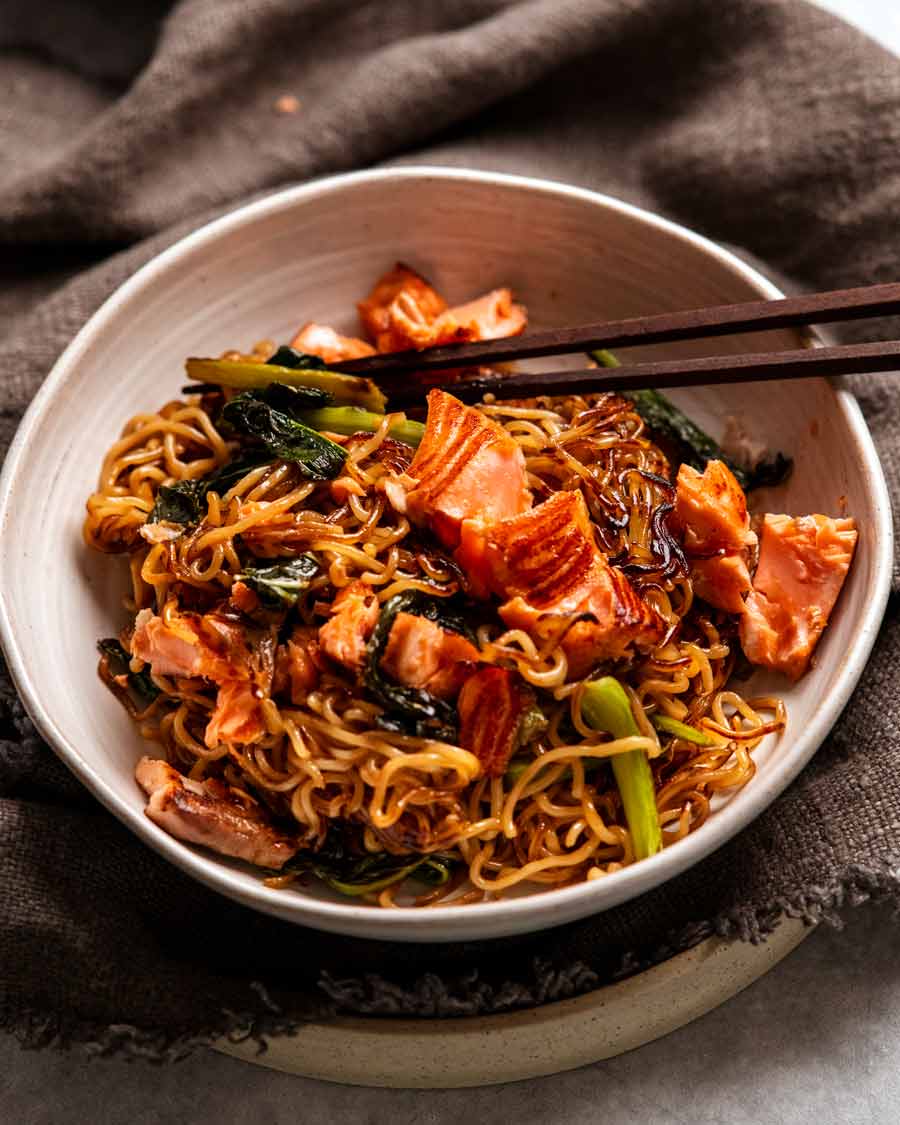
Teriyaki Salmon Noodles
My mother is such a stickler for the traditional in Japanese foods that she once wrote a furious letter to a TV network after watching a celebrity chef make what she judged to be total mockery of authentic tempura. She also rolled her eyes dramatically and flailed her arms in protest when she saw Jamie Oliver making ramen with soba noodles. “THAT’S NOT RAMEN!!!”, she yelled at the television.
Well, mum. Let’s just get this out of the way right upfront. I am not declaring this to be an authentic Japanese recipe!! 😂 However, I HAVE swiped the sauce from your traditional Teriyaki Chicken recipe for these noodles. It’s perfect as a double-duty sauce – for flavouring the salmon AND using as the sauce for the noodles!
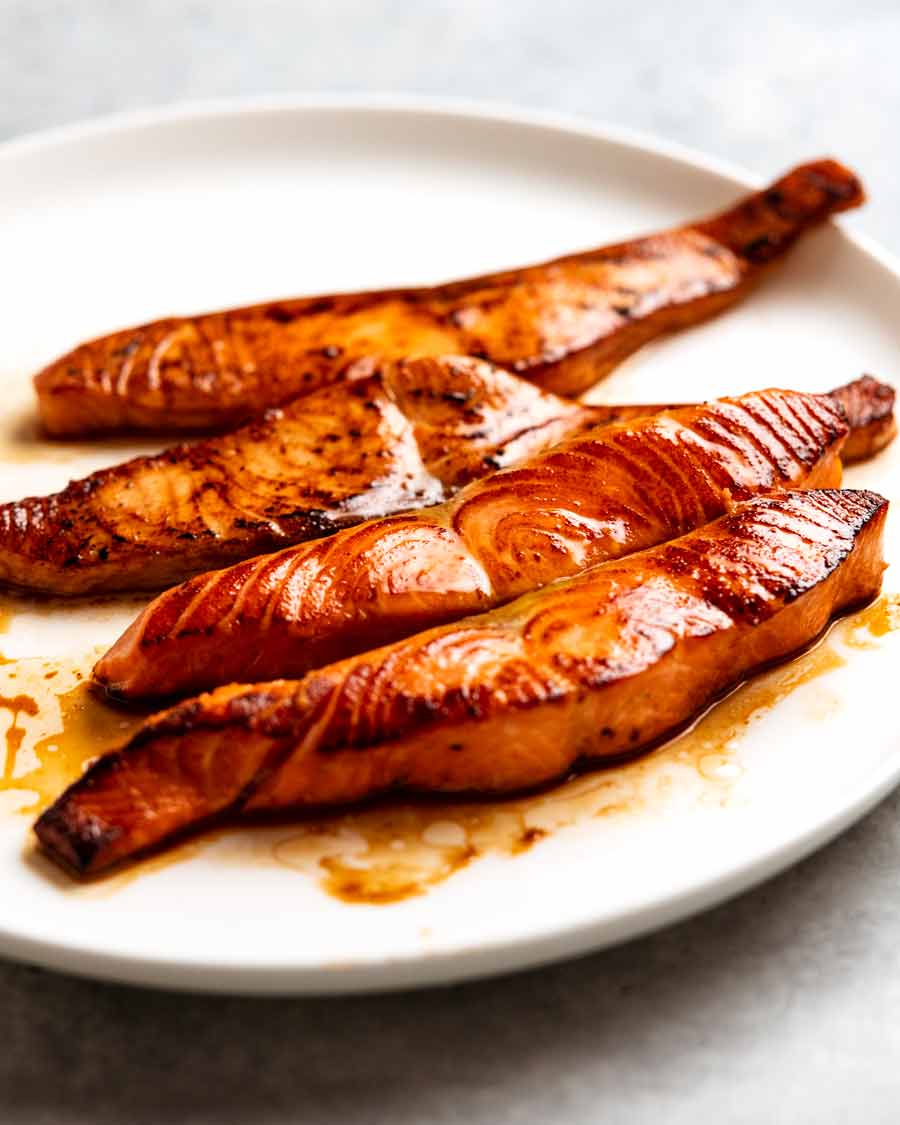
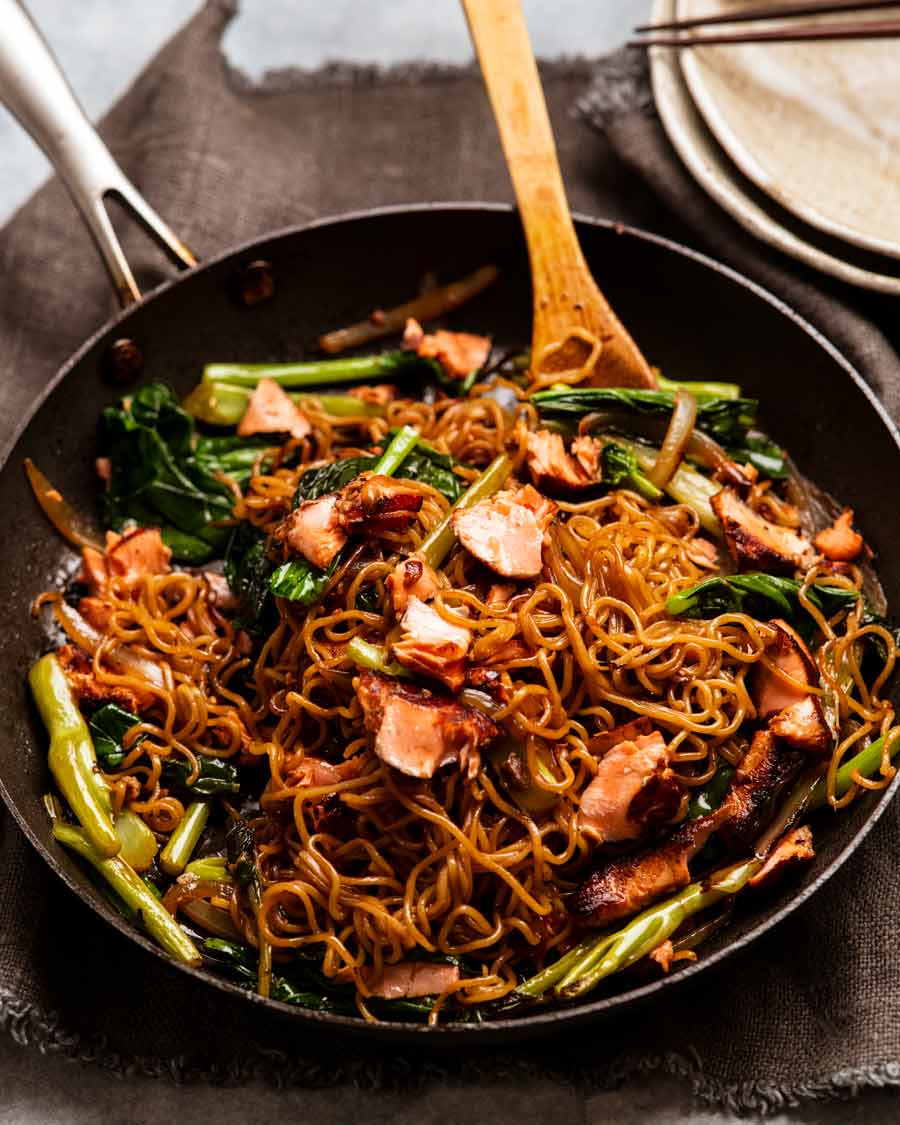
What you need
Here’s what you need for this not-authentic-but-totally-delicious Teriyaki Salmon Noodles!

Salmon – Anywhere between 200 to 250g / 7 – 8oz salmon. Skinless is convenient, though if you can only get skin-on that’s fine too as the cooked flesh comes off the skin easily. You can use fillets, or cutlets with the bones removed.
Alternative fish: Ocean trout, but any fish really. Other proteins: This recipe would also work just fine with other meats such as bite-size strips of chicken, beef, pork. I’d scale up the sauce slightly however if using pieces of these meats (more surface area to flavour).
Noodles – I’ve used dried ramen noodles because it’s what I always have in stock in my pantry. While I actually prefer the flavour and texture of fresh noodles, I don’t always have them. Other dried noodles (yellow, white, rice noodles) and fresh noodles will work as well, see recipe notes for quantities. In the event of an emergency, spaghetti is fine too. Seriously!!! (Try it, most people can’t tell the difference 😂).
Chinese broccoli (gai lan / kai lan) – Probably my most used Asian vegetable, for sheer convenience (easy to chop) and also because I like the “broccoli” like texture of the stems. Substitute with any leafy Asian greens like choy sum, bok choy, pak choy, or about 2 1/2 cups of other vegetables sliced into stir fry-suitable sizes (eg. carrots and zucchini sliced on the diagonal).
Onion and garlic – Essential flavour base ingredients I use for virtually every stir fry. Especially garlic!
No self-respecting Japanese cook would ever call something “teriyaki” without using mirin and cooking sake!
Teriyaki Sauce
While I’ve been very up front about how this recipe is not a traditional Japanese dish (there is no such thing as teriyaki noodles in Japan!), the sauce ingredients are authentic.
Soy sauce – All-purpose Japanese soy sauce (my family uses Kikkoman brand) or light soy sauce. Please don’t use dark soy sauce, the flavour is far too intense and won’t work for this recipe! Sweet soy sauce (eg. kecap manis) is also unsuitable. More on different types of soy sauces here.
Cooking sake and mirin – Two types of rice wines that are essential to Japanese cooking. No self-respecting Japanese restaurant or cook would ever call something “teriyaki” without using these! Nowadays, both are readily available at major supermarkets here in Australia and of course at Asian stores (where they’re better value!).
To achieve a truly great teriyaki flavour, I can’t offer a decent substitute for mirin. However, the sake can be substituted with dry sherry or Chinese cooking wine.
Alcohol content note: The alcohol in cooking wine mostly evaporates when cooked, and the amount of wine used is small to begin with. There will be trace amounts remaining but it’s so negligible it’s barely worth acknowledging.
Sugar – Typically used in Teriyaki Sauce to make it a bit glossy and syrupy so it coats chicken nicely. In this recipe, it also helps the noodles caramelise, which adds flavour. It doesn’t make this dish noticeably sweet as there is only 1 teaspoon, a small amount compared to the volume of ingredients used.
How to make Teriyaki Salmon Noodles
A nice and easy 15-minute recipe! Teriyaki-seasoned salmon is firstly pan-seared and then set aside. We toss the noodles in the same pan before returning the salmon to the skillet and breaking it up into nice big chunks to mix through.
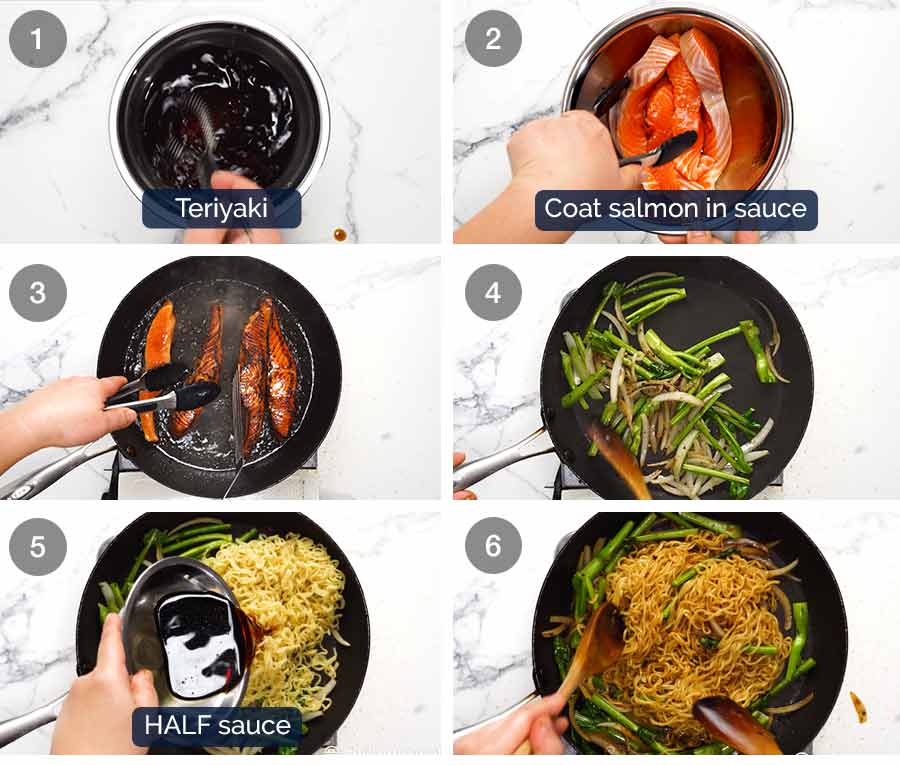
Flavour tip: more caramelisation on the noodles = more flavour!
Teriyaki Sauce – Mix the ingredients in a bowl.
Coat salmon in 1 tablespoon of the Teriyaki Sauce. No need to marinate – we’re cutting the salmon into thin-ish strips, which affords a good amount of salmon surface area for the Teriyaki Sauce to cover. The strips mean it also speeds up the cooking time. Win, win!
Cook salmon for just 1 1/2 minutes on each side until golden and just cooked through. The thin strips cook quickly! Once cooked, remove to a plate and set aside.
Sauté aromatics – Give the pan a quick wipe (else we’ll end up with burnt teriyaki sauce throughout our noodles). Next we give the onion and garlic a head start before adding the Chinese broccoli stems. We won’t add the leafy part of the Chinese broccoli until towards the end as they take barely a minute to wilt.
HALF the sauce – Add the noodles then just HALF the sauce. This allows the noodles to absorb the sauce faster so we can get nicer caramelisation on the noodles as they cook. If you add all the sauce at the same time, it takes almost double the time for the sauce to reduce.
Toss the noodles until the sauce is absorbed and you no longer see any traces of it in the pan.
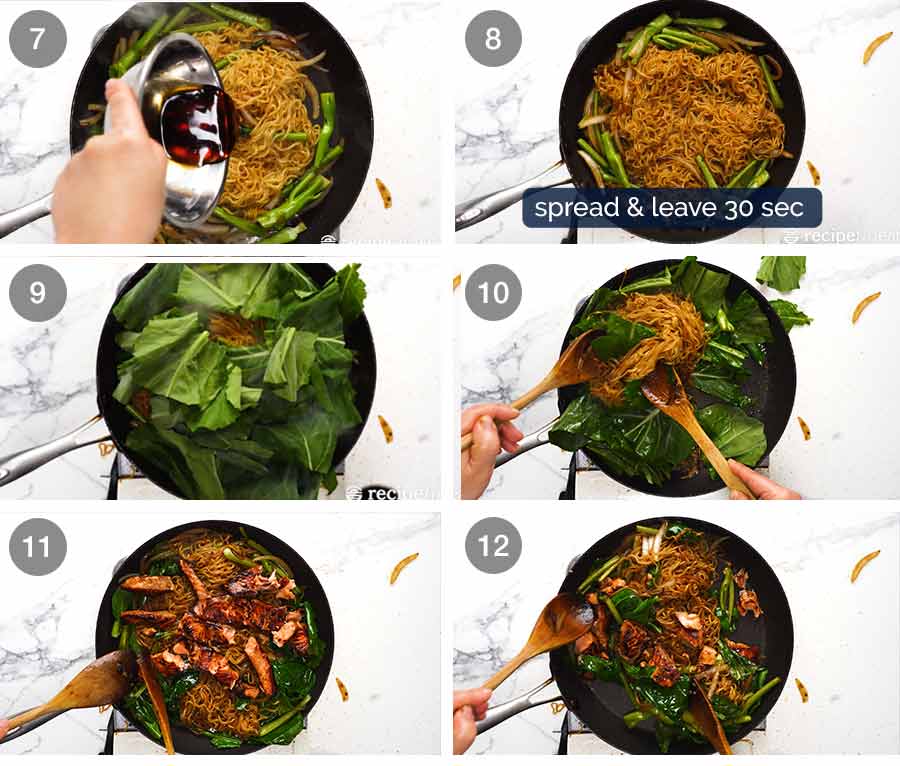
Add remaining sauce then toss to disperse.
Leave 30 seconds – Once the sauce is absorbed again, spread the noodles out and leave them undisturbed for 30 seconds. This encourages caramelisation of the noodles, compared to constantly tossing. Repeat this 3 to 4 times until you see the noodles get some nice colour on them.
Extra oil + leaves – Add a bit of extra oil (again, for caramelisation encouragement!) then toss in the leafy part of the Chinese broccoli.
Toss for another 1 minute or until the leaves wilt.
Return salmon to the pan – Just tumble them on to the noodles along with any juices pooled on the plate.
Serve! Break the salmon into large chunks, and briefly toss through the noodles. That’s it, we’re done. Time to eat. YAY!


These Teriyaki Salmon Noodles are a complete meal (starch, vegetables and protein) so you won’t need to add a side dish. You could also dial up the vegetables in it, if you wanted to. If you add a lot more, you may want to increase the sauce.
Leftovers will keep for however long you’re comfortable keeping cooked salmon for. I personally will happily eat fish up to 3 days after cooking, but I know some people’s comfort limit is 2 days.
Tell me what you think if you try it! As I said in my opening, salmon isn’t cheap and I do think this is a really great dish to make a piece of lovely salmon go a lot further! – Nagi x
Watch how to make it
Hungry for more? Subscribe to my newsletter and follow along on Facebook, Pinterest and Instagram for all of the latest updates.

Teriyaki Salmon Noodles
Ingredients
- 2 tbsp oil (veg or canola)
- 250 g / 8 oz salmon fillet (s), skinless, sliced into 2cm / 0.7″ strips (lengthwise, Note 1)
- 2 instant noodle / ramen noodle cakes (discard seasoning packs) (Note 2 other noodles)
- 1/2 onion , cut into 1cm / 0.3″ slices
- 1 garlic clove , finely minced
- 1 small bunch Chinese broccoli (gai lan), cut into 5 cm / 2" lengths, leaves separated from stem (Note 3)
Teriyaki Sauce:
- 2 1/2 tbsp soy sauce , light or all-purpose (Note 4)
- 2 tbsp mirin (Note 5)
- 2 tbsp cooking sake (Note 5)
- 1 tsp white sugar
Instructions
- Teriyaki Sauce: Mix the ingredients in a small bowl until the sugar is dissolved.
- Coat salmon with 1 tablespoon of Teriyaki Sauce in a bowl, then set aside while you cook the noodles. (No need to marinate)
- Cook your noodles per the packet directions. Drain, briefly rinse under tap water then set aside.
- Cook salmon: Heat 1/2 tablespoon oil in a large non-stick pan over high heat. Cook the salmon for 1 1/2 minutes on each side or until golden, then remove to a plate. Pour any remaining sauce in the skillet over the salmon.
- Cook aromatics: Roughly clean the pan with a paper towel then return to the stove, still on high heat. Heat 1 tablespoon of the remaining oil and cook the onion and garlic for 30 seconds. Add Chinese broccoli stems and cook for 1 minute.
- Noodles & sauce: Add noodles and half the Sauce. Toss for 2 minutes until the Sauce is absorbed. Add the remaining Sauce and toss to disperse. Then spread the noodles out in the pan, cook for 30 seconds un-disturbed. Repeat again 3 to 4 times (~3 min total) – a trick for nice caramelisation on the noodles (which = flavour!).
- Leafy greens: Drizzle the remaining 1/2 tablespoon oil around the side of the pan, then add the Chinese broccoli leaves. Toss for a further 1 1/2 minutes or until the leaves wilt.
- Add back salmon: Remove pan from stove. Place salmon on top, break into large chunks then toss through.
- Serve: Divide between bowls and serve immediately!
Recipe Notes:
– Other dried noodles: use the same weight (ie 160 – 200g / 6 – 7 oz total). Egg noodles, rice noodles or even spaghetti (YES REALLY!). Prepare per packet directions.
– Fresh noodles (eg hokkien noodles, from the fridge) – use 350g / 12 oz. Prepare per packet directions 3. Veg – Other Chinese greens will work just as well, eg. Choy sum, bok choy. Otherwise use 2.5 cups other sliced veg eg mushrooms, zucchini, carrots, cabbage. 4. Soy sauce – Light or all-purpose is required here. I use Kikkoman for Teriyaki Sauce, a Japanese soy sauce brand (my mother would have my head if I dared to use a Chinese brand for teriyaki – even if it doesn’t really matter!) Do not substitute dark soy (too intense). More on different soy sauces here. 5. Mirin and cooking sake – Teriyaki Sauce is not Teriyaki Sauce without these! These are Japanese cooking essentials, widely available at grocery stores these days. Both are alcoholic cooking liquors. See in post for more information about these, including addressing concerns about alcohol content (spoiler: don’t be too concerned!) Substitute: I can’t offer a decent substitute for mirin. However, the sake can be substituted with dry sherry or Chinese cooking wine. If you can’t consume alcohol, use the sauce in this Asian Beef Noodles instead. It’s not Teriyaki but it’s a tasty Asian sauce that will work for this recipe. Cook exactly per this recipe (including coating salmon). 6. Leftovers will keep for 2 days in the fridge.
Love noodles?
Me too! See?Nutrition Information:
Life of Dozer
I always poo-pooed the saying that “all dogs look like their owners”, with Dozer’s mass of golden fur and my jet black hair.
But the resemblance here is uncanny!!😂
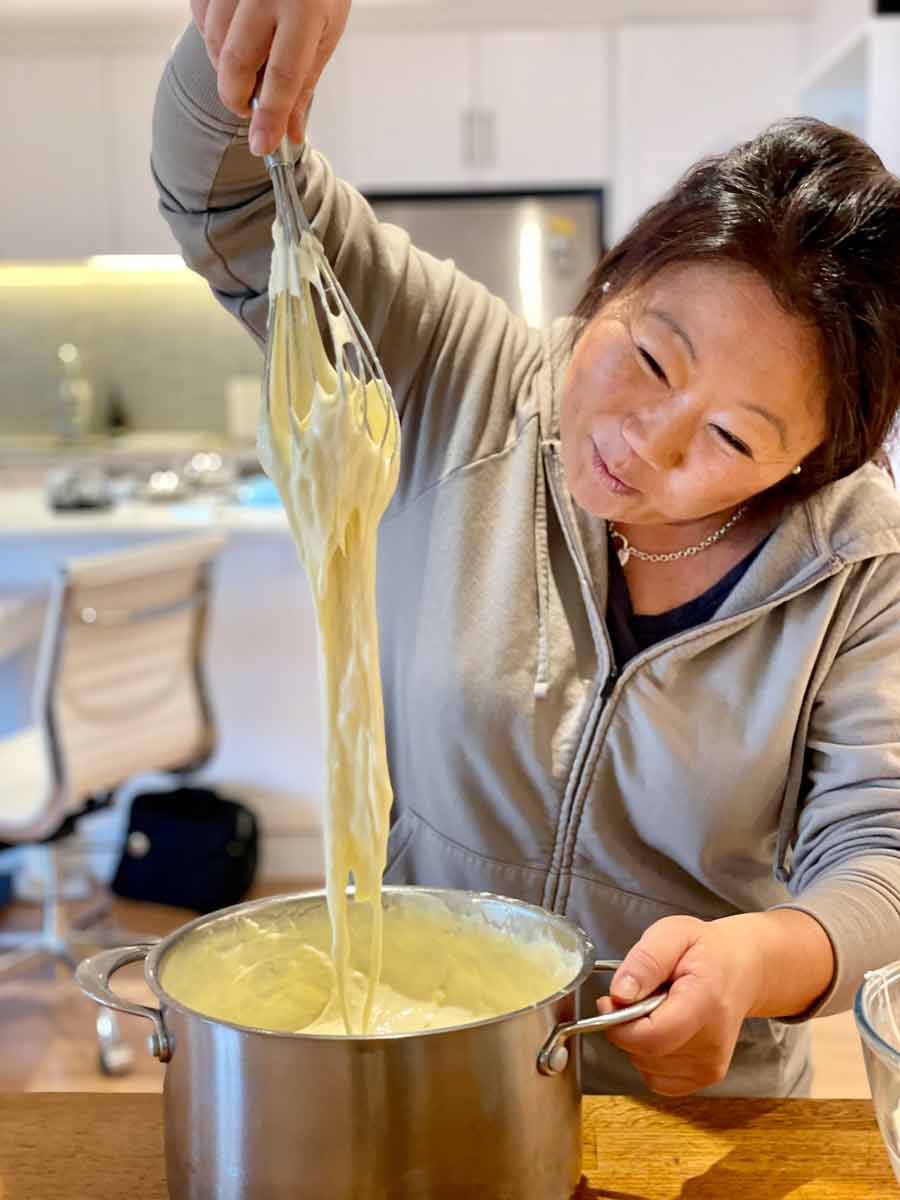






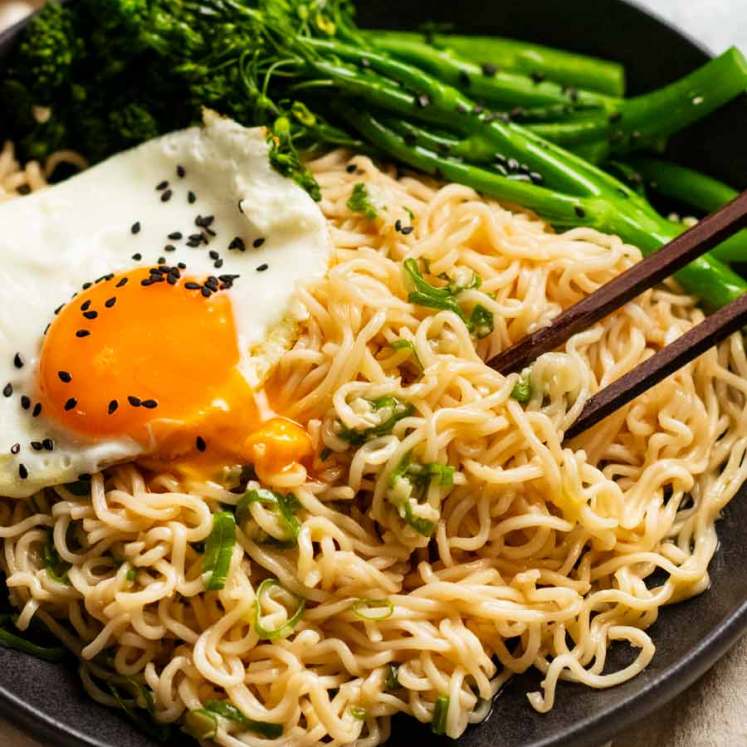

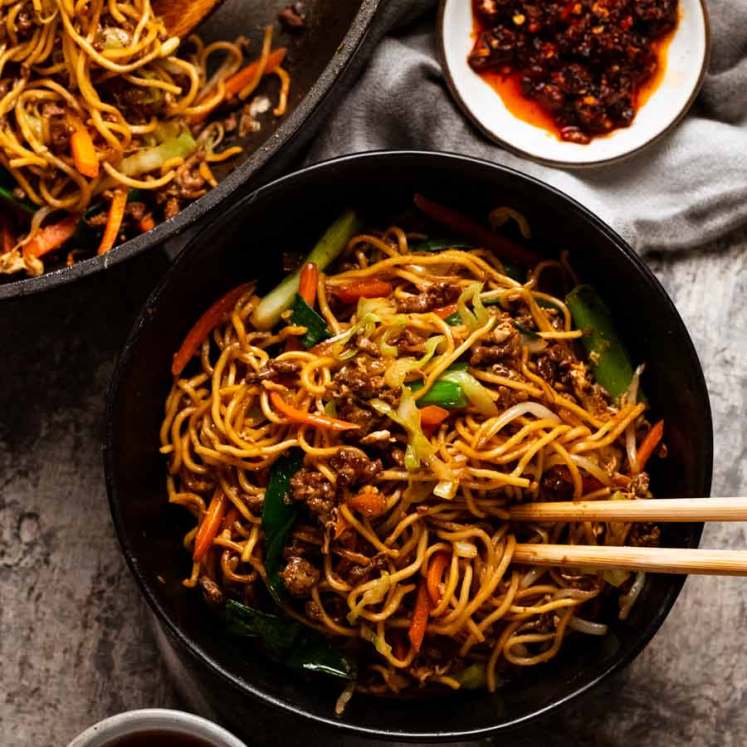
This was so good! I added 3C baby bok choy. We will make again. Our Golden says hi to Dozer
Our 11 yr old cooked this for the family tonight. What a hit! Thanks Nagi.
Had this again tonight. So very good
Deeelish. Another recipe for the Love It file. So quick too. Thank you.
Absolutely love your recipes. I have tried and loved so many of them. I am going to try this one today and I know it will be good. I will be using broccolli and mushrooms. Thank you so much Nagi. x
Love this way of cooking salmon. Have made it a couple of times but do add a little bit of 🌶
This is one of my favorite recipes!!! For less carbs I do a mix of ramen noodles and zucchini noodles or some times just zucchini noodles. So delicious!!!
I’m a big fan of beef teriyaki, home made but my sauce is different from yours. I use 2 garlic and 2 cm fresh ginger, also mirin, sake, soy sauce, oystersauce and pepper.
I have used yors for the salmon, I was afraid mine’s is too heavy for a delicate salmon. I loved every bite of it.
Greetings from the Netherlands.
I have made this two weeks in a row for my family and it’s a huge hit! Hubby, Mr 8 and Miss 4 all loved it. We subbed the broccolini for green beans, edamame beans and spinach as that’s what we had on hand and I used soba noodles as they are a family fave. Will definitely be added to our meal rotation. Thanks for all your amazing recipes – your site is my go to if I want to make a particular type of meal.
Go to recipe for lazy nights. I use Chinese cooking wine and chopped up broccoli florets instead. Husband and young kids love it.
I’m working all weekend and have a side of salmon in the fridge. What a lunch this will be!
Fab as always. I subbed rice vinegar + a bit of extra sugar for the mirin, and I thought it worked pretty well. Will get some mirin for next time though!
Each time I make a Nagi recipe, I say, “this is the best one yet.” But this one may be the best one ever. Hits all my favorite flavor profiles and sooo easy and quick. Threw in a little hot pepper flakes just cause I like the heat!
Another easy recipe with so much flavour. This is my go to whenever I get a craving for salmon now.
Have tried it with several different noodles and Asian veges my favourite usually being soba noodles & bok choy.
Made this for dinner tonight, was one of the best recipes I’ve tried! Was delicious will 100% be making again
Simple & quick, yet super tasty! Will def cook again 🙂 I used dry Pad Thai rice noodles & it was perfect. Thanks x
Excellent!
Made this last night, I didn’t have mirin so used a little oyster sauce. Didn’t have chinese brocolli so used brocollini. Two thumbs up form the Hubster
I think this has become my new favourite recipe. Tonight will be my 4th time to prepare it since I first read it over. Today will be with salmon again, but I have also made it with prawns and even crab seafood sticks. I went from a person who had never fixed ramen noodles, to putting two packs on my shopping list every week. Delicious Nagi, thank you once again!
I never knew teriyaki was so simple to make!! This was delicious, I used crispy tofu instead of salmon, it was wonderful!